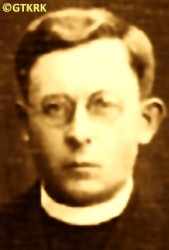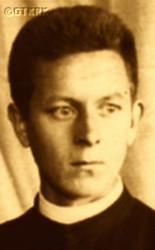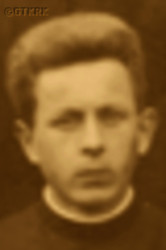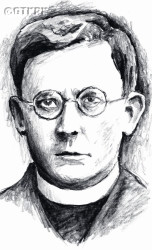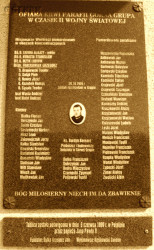Roman Catholic
St Sigismund parish
05-507 Słomczyn
85 Wiślana Str.
Konstancin deanery
Warsaw archdiocese, Poland
full list:
displayClick to display full list

searchClick to search full list by categories
wyświetlKliknij by wyświetlić pełną listę po polsku

szukajKliknij by przeszukać listę wg kategorii po polsku

Martyrology of the clergy — Poland
XX century (1914 – 1989)
personal data
religious status
Servant of God
surname
HUWER
forename(s)
Joseph (pl. Józef)
function
religious cleric
creed
Latin (Roman Catholic) Church RCmore on
en.wikipedia.org
[access: 2014.09.21]
congregation
Society of the Divine Word (i.e. Verbite Fathers) SVDmore on
en.wikipedia.org
[access: 2013.05.19]
(i.e. Verbites, Divine Word Missionaries, Steyler Missionaries)
honorary titles
„Iron Cross” i.e. Germ. „Eisernes Kreuz” (German Empire) — 2nd classmore on
en.wikipedia.org
[access: 2020.04.25]
(1917)
date and place
of death
09.01.1941

KL Buchenwaldconcentration camp
today: n. Weimar, Weimar urban dist., Thuringia state, Germany
more on
en.wikipedia.org
[access: 2022.01.09]
details of death
During World War I, voluntarily joined in 12.1914 the German Imperial Army.
Served in the Germ. 2. Schlesischer Jägerbataillon Nr. 6 (Eng. 6th Rifle Battalion — 2nd Silesian Jäger Battalion), stationed in Oleśnica, part of the 6th Army Corps.
The initial combat route included fights on the Western Front: 01.01.1915‐31.07.1916 — the trench warfare in the vicinity of Verdun.
In 1915 wounded in the back.
The further combat route covered many fronts: 08.08.1916‐20.04.1917 — fighting in the vicinity of Ternopil in Ukraine; 26.04‐18.11.1917 — fights in Flanders, on the line of Siegfried, on the Meuse and the Moselle; 22.11.1917‐16.02.1918 — mountain battles in the Venetian Alps and Upper Alsace; 17.02‐12.11.1918 — French front; 06.01.1919 — return to the garrison in Oleśnica.
Prob. went through the entire combat trail (although four full compliments of the battalion were killed during the fighting — over 2,500 soldiers).
After German and Russian invasion of Poland in 09.1939 and start of the World War II, after start of German occupation, interned by the Germans on 14.03.1940.
Jailed in IL Bruckau transit camp in Bruczków set–up in his own Congregation's missionary house.
Rejected an offer of voluntary deportation to German‐run Germ. Generalgouvernement (Eng. General Governorate).
On 15‐16.08.1940, by the request of Germ. Geheime Staatspolizei (Eng. Secret State Police), i.e. Gestapo from Poznań, transported to KL Buchenwald concentration camp.
There slaved in a quarries — from 27.08.1940 in Germ. arbeit–kommando (Eng. working unit) No. 53, and from 03.10.1940 in Germ. arbeit–kommando No. 41.
Soon perished.
According to death report, issued in KL Buchenwald, the „honest” otherwise German „medical doctors” and formalists — and at the same time, unrivaled fairy tale spinners — noted that Germ. „Der Pole Josef Huwer, geb. am 14.3.1895 in Rigan, eingeliefert am 16.08.40 durch Stapol. Posen, ist heute um 1.35 Uhr gestorben. Todesursache: Herzschwäche bei exaudativer Pleuritis rechts” (Eng. „The Pole Leon Haronski, born on 14.3.1895 in Rogów, apprehended on 16.08.40 by state police Poznań, died today at 2:30 a.m. Cause of death: Heart failure with exudative pleurisy on the right”).
prisoner camp's numbers
2401Click to display source page (KL BuchenwaldClick to display the description)
cause of death
extermination: exhaustion and starvation
perpetrators
Germans
sites and events
KL BuchenwaldClick to display the description, GeneralgouvernementClick to display the description, IL BruckauClick to display the description, Reichsgau WarthelandClick to display the description, «Intelligenzaktion Schlesien»Click to display the description, «Intelligenzaktion»Click to display the description, Ribbentrop‐MolotovClick to display the description, Pius XI's encyclicalsClick to display the description, Upper Silesians in the German Imperial ArmyClick to display the description
date and place
of birth
14.03.1895

Rogówtoday: Gorzyce gm., Wodzisław Śląski pov., Silesia voiv., Poland
more on
en.wikipedia.org
[access: 2022.01.28]
parents
HUWER John
🞲 ?, ? — 🕆 ?, ?

MROZEK Joanna
🞲 ?, ? — 🕆 ?, ?
baptism
16.03.1895

Rogówtoday: Gorzyce gm., Wodzisław Śląski pov., Silesia voiv., Poland
more on
en.wikipedia.org
[access: 2022.01.28]
St Martin the Bishop and Confessor RC church
religious vows
03.04.1920 (temporary)
29.09.1923 (permanent)
presbyter (holy orders)
ordination
13.05.1925

Maria EnzersdorfSt Gabriel missionhouse
today: Mödling dist., Lower Austria state, Austria
more on
en.wikipedia.org
[access: 2021.12.18]
positions held
24.05.1939 – 1940
rector — Bruczkówtoday: Borek Wielkopolski gm., Gostyń pov., Greater Poland voiv., Poland
more on
en.wikipedia.org
[access: 2021.12.18] ⋄ Sacred Heart of Jesus Missionhouse, Verbites SVD — also: prefect of the clerics
1932 – 1939
treasury officer / procurator — Bruczkówtoday: Borek Wielkopolski gm., Gostyń pov., Greater Poland voiv., Poland
more on
en.wikipedia.org
[access: 2021.12.18] ⋄ Sacred Heart of Jesus Missionhouse, Verbites SVD — also: farm manager, teacher of mathematics and languages, including Polish, in the Minor Seminary (gymnasium)
1930 – 1932
vice–rector — Blattentoday: Westlich dist., Valais can., Switzerland
more on
en.wikipedia.org
[access: 2022.10.06] ⋄ Missionhouse, Verbites SVD — on treatment, in connection with gas poisoning during an experiment in Poznań
1928 – 1930
student — Poznańtoday: Poznań city pov., Greater Poland voiv., Poland
more on
en.wikipedia.org
[access: 2021.07.18] ⋄ Department of Mathematics and Natural Sciences, Poznań University [i.e. Adam Mickiewicz University (from 1955) / Poznań University (1945‐1955, 1920‐1939) / Piast University (1919‐1920) / Polish University (1918‐1919) / Royal Academy (1903‐1918)] — also: chaplain of Ursuline Nuns' Congregation house by St Adalbert parish
1926 – 1928
treasury officer / procurator — Górna Grupatoday: Dragacz gm., Świecie pov., Kuyavia‐Pomerania voiv., Poland
more on
en.wikipedia.org
[access: 2021.09.02] ⋄ St Joseph Missionhouse, Verbites SVD
1920 – 1926
student — Maria Enzersdorftoday: Mödling dist., Lower Austria state, Austria
more on
en.wikipedia.org
[access: 2021.12.18] ⋄ philosophy and theology, Higher Theological Seminary in St Gabriel Missionhouse, Verbites SVD
16.03.1919 – 1921
novitiate — Maria Enzersdorftoday: Mödling dist., Lower Austria state, Austria
more on
en.wikipedia.org
[access: 2021.12.18] ⋄ St Gabriel Missionhouse, Verbites SVD
1914
pupil — Maria Enzersdorftoday: Mödling dist., Lower Austria state, Austria
more on
en.wikipedia.org
[access: 2021.12.18] ⋄ Minor Theological Seminary (lyceum) in St Gabriel Missionhouse, Verbites SVD
03.10.1909 – 17.07.1914
pupil — Nysatoday: Nysa gm., Nysa pov., Opole voiv., Poland
more on
en.wikipedia.org
[access: 2021.04.02] ⋄ Minor Theological Seminary (gymnasium) in Holy Cross Mission House, Verbites SVD
others related
in death
BUKOWSKIClick to display biography Leopold, DOMERACKIClick to display biography Joseph Valentine, DRWALClick to display biography Francis, DRWĘSKIClick to display biography Stanislav Felix (Bro. Felician), GLAKOWSKIClick to display biography Stanislav, HANKEClick to display biography Francis, HAROŃSKIClick to display biography Leo Joseph, KULISZClick to display biography Charles, KUPILASClick to display biography Francis, LANGNERClick to display biography Herbert, PANKOWSKIClick to display biography Marian, POLEDNIAClick to display biography Paul, ROGACZEWSKIClick to display biography Adalbert Theophilus, SCHULZClick to display biography Joseph Valentine, SEKRECKIClick to display biography Henry, STOCKClick to display biography Joseph
sites and events
descriptions
KL Buchenwald: In German Germ. Konzentrationslager (Eng. concentration camp) KL Buchenwald concentration camp, founded in 1937 and operational till 1945, Germans held c. 238,380 prisoners and murdered approx. 56,000 of them, among them thousands of Poles. Prisoners were victims of pseudo‐scientific experiments, conducted among others by Behring‐Werke from Marburg and Robert Koch Institute from Berlin companies. They slaved for Gustloff in Weimar and Fritz‐Sauckel companies manufacturing armaments. To support Erla‐Maschinenwerk GmbH in Leipzig, Junkers in Schönebeck (airplanes) and Rautal in Wernigerode Germans organized special sub‐camps. In 1945 there were more than 100 such sub‐camps. Dora concentration camp was initially one of them, as well as KL Ravensbrück sub‐camps (from 08.1944). On 08.04.1945 Polish prisoner, Mr Guido Damazyn, used clandestinely constructed short wave transmitter to sent, together with a Russian prisoner, a short message begging for help. It was received and he got a reply: „KZ Bu. Hold out. Rushing to your aid. Staff of Third Army” (American). Three days later the camp was liberated. (more on: www.buchenwald.deClick to attempt to display webpage
[access: 2013.08.10], en.wikipedia.orgClick to attempt to display webpage
[access: 2013.08.10])
Generalgouvernement: After the Polish defeat in the 09.1939 campaign, which was the result of the Ribbentrop‐Molotov Pact and constituted the first stage of World War II, and the beginning of German occupation in part of Poland (in the other, eastern part of Poland, the Russian occupation began), the Germans divided the occupied Polish territory into five main regions. In two of them new German provinces were created, two other were incorporated into other provinces. However, the fifth part was treated separately, and in a political sense it was supposed to recreate the German idea from 1915 (during World War I, after the defeat of the Russians in the Battle of Gorlice in 05.1915) of creating a Polish enclave within Germany. Illegal in the sense of international law, i.e. Hague Convention, and public law, managed by the Germans according to separate laws — especially established for the Polish Germ. Untermenschen (Eng. subhumans) — till the Russian offensive in 1945 it constituted part of the Germ. Großdeutschland (Eng. Greater Germany). Till 31.07.1940 formally called Germ. Generalgouvernement für die besetzten polnischen Gebiete (Eng. General Government for the occupied Polish lands) — later simply Germ. Generalgouvernement (Eng. General Governorate), as in the years 1915‐1918. From 07.1941, i.e. after the German attack on 22.06.1941 against the erstwhile ally, the Russians, it also included the Galicia district, i.e. the Polish pre‐war south‐eastern voivodeships. A special criminal law was enacted and applied to Poles and Jews, allowing for the arbitrary administration of the death penalty regardless of the age of the „perpetrator”, and sanctioning the use of collective responsibility. After the end of the military conflict of the World War UU, the government of the Germ. Generalgouvernement was recognized as a criminal organization, and its leader, governor Hans Frank, guilty of war crimes and crimes against humanity and executed. (more on: en.wikipedia.orgClick to attempt to display webpage
[access: 2024.12.13])
IL Bruckau: The Gestapo District Office in Poznań issued on 13.12.1939 executive instruction Ref. IIB No. 406/39 Tgb. No. 3045/39, ordering: „Based on the regulation of the Germ. Höherer SS‐ und Polizeiführer (Eng. Higher Commander of the SS and Police) [of the German province of Warthegau (Eng. Greater Poland)] of 12.11.1939 [SS‐Gruppenführer Wilhelm Koppe], apart from Poles and Jews, also Catholic clergy will be expelled. Action against this group of people should be carried out in such a way that internment and transport are separate […] C. 80% of Catholic clergy are expected to be expelled. The selection based on political threat posed. Internees cannot be placed in regular transit camps due to the possibility of international protest. Catholic clergy should be interned in men's monasteries and held there till mass transportation out”. One of them was the Divine Word Missionaries SVD house in Bruczków, c. 15 km from Jarocin, where the Germans — Geheime Staatspolizei (Eng. Secret State Police), i.e. Gestapo — created the German „Internierungslager” (Eng. „internment camp”) IL Bruckau for the Polish clergy. From c. 14.03.1940, 56 Polish priests and 12 friars, were held there. In 08.1940, most of them were sent to the German concentration camps KL Buchenwald and KL Dachau. From 12.1941, by order of the SS‐Obergruppenführer, Germ. Gauleiter (Eng. district head) of the German National Socialist Party and Germ. Reichsstatthalter (Eng. Reich Governor) of Germ. Warthegau province, Arthur Charles Greiser, a germanization facility for Polish children, grabbed by the Germans from Polish orphanages (e.g. Olsztyn) and families, was established in the SVD Congregation's house. The Austrian „psychologist” Hildegard Hetzel decided there whether children were „suitable for Germanization” (after the end of the war, she continued her career as a university psychologist, claiming that „did not know” how the results of her research „were to be used”). In 1942, there prob. was a strike of 15 children who were taken to the vicinity of Poznań and murdered by the Germans. (more on: www.bruczkow.powiatgostyn.plClick to attempt to display webpage
[access: 2013.06.23])
Reichsgau Wartheland: After the Polish defeat in the 09.1939 campaign, which was the result of the Ribbentrop‐Molotov Pact and constituted the first stage of World War II, and the beginning of German occupation in part of Poland (in the other, eastern part of Poland, the Russian occupation began), the Germans divided the occupied Polish territory into five main regions (and a few smaller). The largest one was transformed into Germ. Generalgouvernement (Eng. General Governorate), intended exclusively for Poles and Jews and constituting part of the so‐called Germ. Großdeutschland (Eng. Greater Germany). Two were added to existing German provinces. From two other separate new provinces were created. Greater Poland region was one of them, incorporated into Germany on 08.10.1939, by decree of the German leader Adolf Hitler (formally came into force on 26.10.1939), and on 24.01.1940 transformed into the Germ. Reichsgau Wartheland (Eng. Wartheland Reich Province), in which the law of the German state was to apply. The main axis of the policy of the new province, the territory of which the Germans recognized as the Germ. „Ursprünglich Deutsche” (Eng. „natively German”), despite the fact that 90% of its inhabitants were Poles, was Germ. „Entpolonisierung” (Eng. „Depolonisation”), i.e. forced Germanization. C. 100,000 Poles were murdered as part of the Germ. „Intelligenzaktion”, i.e. extermination of Polish intelligentsia and ruling classes. C. 630,000 were forcibly resettled to the Germ. Generalgouvernement, and their place taken by the Germans brought from other areas occupied by Germany (e.g. the Baltic countries, Bessarabia, Bukovina, etc.). Poles were forced to sign the German nationality list, the Germ. Deutsche Volksliste DVL. As part of the policy of „Ohne Gott, ohne Religion, ohne Priesters und Sakramenten” (Eng. „No God, no religion, no priest or sacrament”) most Catholic priests were arrested and sent to concentration camps. All schools teaching in Polish, Polish libraries, theaters and museums were closed. Polish landed estates confiscated. To further reduce the number of the Polish population, Poles were sent to forced labor deep inside Germany, and the legal age of marriage for Poles was increased (25 for women, 28 for men). The German state office, Germ. Rasse‐ und Siedlungshauptamt (Eng. Main Office of Race and Settlement) RuSHA, under the majesty of German law, abducted several thousand children who met specific racial criteria from Polish families and subjected them to forced Germanization, handing them over to German families. After the end of hostilities of World War II, the overseer of this province, the Germ. Reichsstatthalter (Eng. Reich Governor) and the Germ. Gauleiter (Eng. district head) of the German National Socialist Party, Arthur Karl Greiser, was executed. (more on: en.wikipedia.orgClick to attempt to display webpage
[access: 2024.06.21])
«Intelligenzaktion Schlesien»: A planned action of arrests and extermination of Polish Upper Silesia intellectual elite in general recorded in of the so‐called Germ. Sonderfahndungsliste (Eng. Special Wanted List), i.e. a proscription list of names of „enemies of the Reich” — participants of Upper Silesia uprisings, former Polish plebiscite activists, journalists, politicians, intellectuals, civil servants, priests — organised by Germans mainly in 04‐05.1940, aiming at total Germanisation of the region. The relevant decree, no IV‐D2‐480/40, was issued by the RSHA, i.e. Germ. Reichssicherheitshauptamt (Eng. Reich Security Office), and signed by Heinrich Himmler or Reinhard Heydrich. Some of those arrested were murdered in mass executions, some were deported to the German‐run Germ. Generalgouvernement (Eng. General Governorate), and some were sent to concentration camps. The personal details of 3,047 people deported within two months of 1940 were established. Among the victims were 33 Catholic priests, 22 of whom perished in concentration camps (the clergy were sent — in 5 transports — first to KL Dachau, and then to KL Gusen, where they slaved in quarries). Altogether, the Germans murdered c. 2,000 members of the Polish Upper Silesia intellectual elite. (more on: pl.wikipedia.orgClick to attempt to display webpage
[access: 2016.05.30])
«Intelligenzaktion»: German: «Intelligenzaktion» (English: „Intelligence Action”) — a German program of extermination of the Polish elite, mainly the intelligentsia and leadership layers, carried out from the beginning of the occupation in w 09.1939 to 04.1940, mainly in territories directly annexed to Germany, but also in the so‐called Germ. Generalgouvernement (Eng. General Governorate), where it was called «AB‐aktion». In the first phase, immediately after the beginning of the German occupation, during military operations carried out by the Germ. Wehrmacht (Eng. Armed Forces) and the genocidal units of the Germ. Einsatzgruppen (Eng. Operational Groups) of the Germ. Sicherheitspolizei (Eng. Security Police), i.e. SiPo, and Germ. Sicherheitsdienst des Reichsführers SS (Eng. Security Service of the Reichsführer SS), i.e. SD, organized by the Germ. Reichssicherheitshauptamt (Eng. Reich Main Security Office), i.e. RSHA, which followed the troops, carried out under the Germ. Unternehmen „Tannenberg” (Eng. Operation „Tannenberg”) — based on the so‐called Germ. Sonderfahndungsliste (Eng. Special Wanted Lists), i.e. proscription lists of Poles considered particularly dangerous to the Third Reich, prepared by the Zentralstelle II/P (Polen) unit of the German RSHA. Later, implemented by the German civilian occupation authorities and the genocidal unit of the Germ. Volksdeutscher Selbstschutz (Eng. Ethnic Germans Self‐Defense), whose members were Germ. Volksdeutsche (Eng. Ethnic Germans), i.e. representatives of the German minority in Poland. According to various sources, these lists, at the beginning of 09.1939, could have contained the details of 61,000—88,000 „dangerous” Poles — although these figures cannot be confirmed. In total, during this genocide, c. 50,000 teachers, Catholic priests, representatives of the landed gentry, freelancers, social and political activists, and retired military personnel were systematically and methodically murdered. Another 50,000 were sent to concentration camps, where only a negligible percentage survived. (more on: en.wikipedia.orgClick to attempt to display webpage
[access: 2014.10.04])
Ribbentrop‐Molotov: Genocidal Russian‐German alliance pact between Russian leader Joseph Stalin and German leader Adolf Hitler signed on 23.08.1939 in Moscow by respective foreign ministers, Mr. Vyacheslav Molotov for Russia and Joachim von Ribbentrop for Germany. The pact sanctioned and was the direct cause of joint Russian and German invasion of Poland and the outbreak of the World War II in 09.1939. In a political sense, the pact was an attempt to restore the status quo ante before 1914, with one exception, namely the „commercial” exchange of the so‐called „Kingdom of Poland”, which in 1914 was part of the Russian Empire, fore Eastern Galicia (today's western Ukraine), in 1914 belonging to the Austro‐Hungarian Empire. Galicia, including Lviv, was to be taken over by the Russians, the „Kingdom of Poland” — under the name of the General Governorate — Germany. The resultant „war was one of the greatest calamities and dramas of humanity in history, for two atheistic and anti‐Christian ideologies — national and international socialism — rejected God and His fifth Decalogue commandment: Thou shall not kill!” (Abp Stanislav Gądecki, 01.09.2019). The decisions taken — backed up by the betrayal of the formal allies of Poland, France and Germany, which on 12.09.1939, at a joint conference in Abbeville, decided not to provide aid to attacked Poland and not to take military action against Germany (a clear breach of treaty obligations with Poland) — were on 28.09.1939 slightly altered and made more precise when a treaty on „German‐Russian boundaries and friendship” was agreed by the same murderous signatories. One of its findings was establishment of spheres of influence in Central and Eastern Europe and in consequence IV partition of Poland. In one of its secret annexes agreed, that: „the Signatories will not tolerate on its respective territories any Polish propaganda that affects the territory of the other Side. On their respective territories they will suppress all such propaganda and inform each other of the measures taken to accomplish it”. The agreements resulted in a series of meeting between two genocidal organization representing both sides — German Gestapo and Russian NKVD when coordination of efforts to exterminate Polish intelligentsia and Polish leading classes (in Germany called «Intelligenzaktion», in Russia took the form of Katyń massacres) where discussed. Resulted in deaths of hundreds of thousands of Polish intelligentsia, including thousands of priests presented here, and tens of millions of ordinary people,. The results of this Russian‐German pact lasted till 1989 and are still in evidence even today. (more on: en.wikipedia.orgClick to attempt to display webpage
[access: 2015.09.30])
Pius XI's encyclicals: Facing the creation of two totalitarian systems in Europe, which seemed to compete with each other, though there were more similarities than contradictions between them, Pope Pius XI issued in 03.1937 (within 5 days) two encyclicals. In the „Mit brennender Sorge” (Eng. „With Burning Concern”) published on 14.03.1938, condemned the national socialism prevailing in Germany. The Pope wrote: „Whoever, following the old Germanic‐pre‐Christian beliefs, puts various impersonal fate in the place of a personal God, denies the wisdom of God and Providence […], whoever exalts earthly values: race or nation, or state, or state system, representatives of state power or other fundamental values of human society, […] and makes them the highest standard of all values, including religious ones, and idolizes them, this one […] is far from true faith in God and from a worldview corresponding to such faith”. On 19.03.1937, published „Divini Redemptoris” (Eng. „Divine Redeemer”), in which criticized Russian communism, dialectical materialism and the class struggle theory. The Pope wrote: „Communism deprives man of freedom, and therefore the spiritual basis of all life norms. It deprives the human person of all his dignity and any moral support with which he could resist the onslaught of blind passions […] This is the new gospel that Bolshevik and godless communism preaches as a message of salvation and redemption of humanity”… Pius XI demanded that the established human law be subjected to the natural law of God , recommended the implementation of the ideal of a Christian state and society, and called on Catholics to resist. Two years later, National Socialist Germany and Communist Russia came together and started World War II. (more on: www.vatican.vaClick to attempt to display webpage
[access: 2023.05.28], www.vatican.vaClick to attempt to display webpage
[access: 2023.05.28])
Upper Silesians in the German Imperial Army: During World War I, the inhabitants of Upper Silesia — Poles and Germans: men up to 40 years of age — were drafted mainly into the German 12. Division of the Army of the German Empire, which formed part of the Germ. VI. Armee‐Korps (Eng. VI Army Corps), with headquarters in Nysa. After an initial, short expedition to Zagłębie Dąbrowskie (part of the Russian partition) — the troops reached Częstochowa — the division was transferred to the Western Front. On 05‐09.09.1914 took part in the Battle of the Marne (wounded and killed: 455,000 Germans, 372,000 French), when the French stopped the German attack (the so‐called Schlieffen Plan), which led to 4 years of trench warfare. The division fought in the trenches during the Battle of Verdun 21.02‐18.12.1916 (wounded and killed: 338,000 Germans, 348,000 French), with a break for reinforcement and participation in the Battle of the Somme 01.07‐17.11.1916 (wounded and killed: 440,000 Germans, 620,000 French and the British). From 12.1916 to 04.1917 on the Eastern Front, where it did not take part in major battles. In 05‐06.1917 back on the Western Front. On 24.10‐19.11.1917, it took part in the Battle of Caporetto on the Pilava River in Slovenia, supporting the Austro‐Hungarian troops (wounded and killed: 70,000 Austrians, 43,000 Italians, 265,000‐275,000 Italian POWs captured) — in the battle, the Germans used combat gases. In 1918, again on the Western Front: 07‐29.04.1918 in the Battle of Lys, during the German Spring Offensive (also called the Fourth Battle of Ypres — wounded and killed: c. 119,000 Allies, c. 100,000 Germans); and on 08—10.10.1918 in the Battle of Cambrai, during the final Allied counteroffensive (wounded and killed: 12,000 British, 10,000 Germans). In the infantry regiments, losses were to reach 100‐130% of the initial levels, and 10‐15% of soldiers did not return home from the war. In total, c. 780,000‐800,000 Poles fought in the Army of the German Empire, of whom c. 110,000 died and twice as many were wounded or became war invalids. 56,000 soldiers from Upper Silesia died and 28,000 were permanently disabled. (more on: en.wikipedia.orgClick to attempt to display webpage
[access: 2024.07.07])
sources
personal:
ruda_parafianin.republika.plClick to attempt to display webpage
[access: 2013.05.19], www.hagiographycircle.comClick to attempt to display webpage
[access: 2012.11.23], www.gornagrupa.werbisci.plClick to attempt to display webpage
[access: 2019.04.16], svdgg.republika.plClick to attempt to display webpage
[access: 2013.06.23]
bibliographical:
„International Tracing Service (ITS), Bad Arolsen, GermanyClick to display source page”, Arolsen Archives
original images:
bsip.miastorybnik.plClick to attempt to display webpage
[access: 2020.05.25], svdgg.republika.plClick to attempt to display webpage
[access: 2013.06.23], encyklo.plClick to attempt to display webpage
[access: 2016.04.23], docplayer.plClick to attempt to display webpage
[access: 2018.02.15], svdgg.republika.plClick to attempt to display webpage
[access: 2014.03.10]
LETTER to CUSTODIAN/ADMINISTRATOR
If you have an Email client on your communicator/computer — such as Mozilla Thunderbird, Windows Mail or Microsoft Outlook, described at WikipediaPatrz:
en.wikipedia.org, among others — try the link below, please:
LETTER to CUSTODIAN/ADMINISTRATORClick and try to call your own Email client
If however you do not run such a client or the above link is not active please send an email to the Custodian/Administrator using your account — in your customary email/correspondence engine — at the following address:

giving the following as the subject:
MARTYROLOGY: HUWER Joseph
To return to the biography press below:
 Click to return to biography
Click to return to biography








